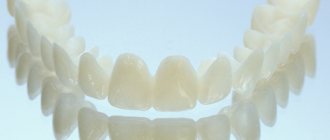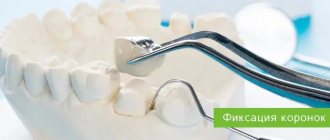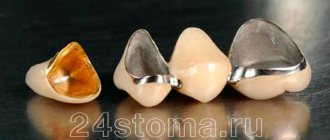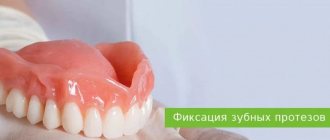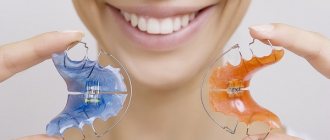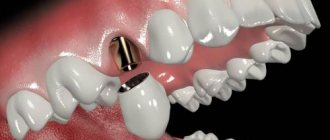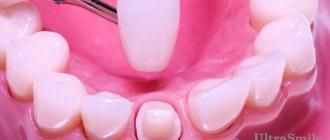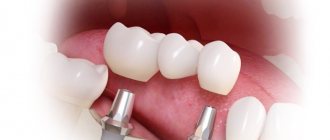According to statistics, in the first year of use, about 13–15% of prosthetic structures made of acrylic and 8–10% of modern thermoplastic materials break. Unfortunately, breakdowns always happen, as circumstances vary. Damage can be caused by injury, excessive load, or improper care of the structure. Many patients who are faced with this situation are interested in whether it is possible to glue a denture and how to do it.
Temporary fixation technology
At the preparatory stage, the surgical field and orthopedic structures that are to be fixed are dried and isolated from saliva. Degreasing of working surfaces is not required. Temporary cement is mixed taking into account the manufacturer's recommendations. In the future, the fixation technique - using the example of temporary acrylic crowns on eugenol-free cement - looks like this.
- Temporary cement is applied with a spatula to the cervical part of the temporary crown.
- Under bite control in habitual or central occlusion, the orthopedic structure is fixed in the oral cavity.
- After the time specified by the manufacturer, the temporary cement is removed.
- If work is carried out in support of a dental implant, a rubber dam is used to protect the latter.
- The final stage is x-ray control to check the effectiveness of cement removal.
- Fixation is completed by control of occlusal contacts.
- The patient receives recommendations on the rules for caring for the structure (they are practically no different from the case of installing fixed structures on permanent cement, with the exception of replacing dental floss with a dental brush).
Preventing the problem from occurring
To reduce the likelihood of dental structures falling out, you should:
- Be treated only in a trusted medical center. Particular attention should be paid to the doctor’s qualifications and work experience. There is no need to look for cheap dentures in the city - price should be the last criterion when it comes to oral health. Main quality.
- Follow all medical prescriptions. Usually the doctor explains in detail how to extend the life of the system. His recommendations should be kept in mind.
- Treat the artificial unit with care. It is unacceptable to chew nuts, foreign objects, open bottles with your teeth, etc.
- Follow the rules of oral hygiene. It is recommended that the crown, like the natural teeth surrounding it, be cleaned with toothpaste and a brush at least twice a day. It is impossible for plaque to be deposited on its surface and stone to form.
- Have preventive dental examinations annually. During them, the doctor examines the condition of the oral cavity and takes measures to prevent the development of dental diseases.
Take care of your teeth. Then your smile will remain beautiful for many years.
Operational characteristics
The degree of fixation depends on the characteristics of the temporary cement. One of its important properties is the retention force, which allows you to hold the structure and remove it if necessary. The optimal characteristics of temporary cements include:
- good adhesion of indirect restoration;
- ease of mixing and application;
- ease of removal after fixation of cement residues from prepared structures and outer surfaces of the crown;
- adequate working hours;
- optimal viscosity for comfortable use;
- easy removal of the structure without damaging nearby tissues;
- biocompatibility with abutment tooth structures and soft tissues;
- long shelf life;
- no effect on the adhesion of permanent cement.
To identify and remove excess cement, it must be radiopaque. Today, none of the temporary cements on the market have absolutely all of the above properties. It is advisable to use each of them for a specific purpose due to the lack of a single universal solution.
Does it hurt to remove a crown?
No, especially if the procedure is performed under anesthesia. Removing a crown from a tooth is painful if there is a living tooth underneath it that is undergoing an inflammatory process, but in the vast majority of cases, crowns are placed on pulpless teeth. In such a situation, the procedure may cause some discomfort, but you most likely will not experience severe pain. If your teeth hurt after removing crowns, there are two options. Either mechanical damage has been caused to the gum, or pulpitis, periodontitis or granuloma develops in the tooth. In this case, complex endodontic treatment is required.
Complications
Due to temporary fixation, the following complications are possible:
- de-cementing;
- damage to the supporting structure;
- breakage of the orthopedic structure during removal;
- development of gingivitis or peri-implantitis due to insufficient removal of temporary cement from the gingival sulcus.
The most severe complication is peri-implantitis, in the event of which it is necessary to remove the structure as quickly as possible, remove excess cement and carry out anti-inflammatory measures.
Breakage of the prosthesis or supporting structures is possible due to too much retention force of the temporary cement. Most often, temporary crowns made of plastic or composite materials break. Correcting the situation is quite simple - the damage is glued together with plastic or composite right in the office.
When permanent structures are removed, the ceramic veneer often chips, which requires the manufacture of a new denture. Therefore, it is undesirable to fix ceramic or metal-ceramic prostheses with temporary cement. The least common cases in orthopedic dentistry are cases of breakage or fracture of the crown of a tooth and other damage to supporting structures. Also considered quite rare is the case of excessive load on the implant with the development of peri-implantitis.
What is a crown and when is it installed?
A crown is a single dental prosthesis that completely replicates the visible part of the tooth. This differs from an inlay or veneer, which imitate only a fragment of a tooth. Installation of a crown is required in case of significant damage to the tooth (30% or more), when classical filling is unable to ensure proper functionality of the dental unit. A crown is also placed when a tooth is lost. In this case, the support for the prosthesis is provided by neighboring teeth or an implant that replaces the root of the lost tooth. Depending on the design features, the method of attaching the crown is selected.
What diet should you follow?
A lot depends on the original condition of the tooth to be restored. So, if the root is strong, approximately half of the tissues of the coronal part are preserved, and the prosthesis itself is installed correctly and professionally, there are no obvious restrictions in terms of load. Stump tabs, which are also used to strengthen the root system, fit very tightly, hold securely and do not require any special changes in nutrition. But if, for example, prosthetics were performed on a pin, the chewing pressure on the tooth must be reduced, since it can lead to displacement of the pin, and subsequently the crown.
In general, recommendations for any type of prosthetics from a nutritional point of view would be as follows:
- limiting the consumption of drinks high in caffeine (tea, coffee) and coloring pigments (wine, beets), especially if you have plastic and metal-plastic crowns that absorb dyes from food and drinks,
- Food that is too cold or too hot should be eaten with great caution - it can lead to cracks and chips of materials, and disruption of their adhesion (fixation). It is also impossible, for example, to immediately drink hot tea after cold ice cream - sudden temperature changes can again provoke the formation of cracks and destruction of dentures, weaken the effect of the fixing adhesive,
- Despite the fairly high strength of crowns and inlays, you need to protect them from excessive loads - it is better to first cut solid food into small pieces,
- teeth with crowns should not be used to open the shells of nuts, such as pistachios,
- If you have dentures, it is recommended to avoid viscous and stringy foods, namely chewing gum and toffees, which can stick to crowns or inlays, and with excessive load and gradual deterioration of the fixation of the prosthesis can lead to its loss.
First of all, crowns that have an external coating that can break off need to be protected from mechanical loads - made of metal-plastic, metal-ceramic or zirconium coated with ceramic.
Conclusion: what to choose?
Based on the results of everything said above, we can conclude that there is no ideal method of fixing crowns, but the optimal one will be the one that best suits a particular patient, provided that it is chosen by a professional based on objective factors. In addition, competent and careful adherence by the orthopedist to the technology will help mitigate any shortcomings and avoid negative consequences.
The VivaDent dental clinic employs just such professional dentists - qualified, experienced and competent, which means that no matter how the crowns are installed on your implants, it will be implemented flawlessly.
Why is it undesirable to do structural repairs at home?
If, after the prosthesis broke, the patient turned to a specialist, then the repair may take only one to two hours. In this case, only safe materials will be used for restoration.
Self-recovery will not only take more time, but will also create the risk of permanent failure of the structure. In addition, if conventional adhesives such as “Moment” are used for repair, this can lead to poisoning of the body or cause a severe allergic reaction.
Rules of conduct when a bridge falls out
What to do if a dental bridge falls off? Often people get lost and don’t know how to behave. Someone almost begins to panic, someone hastily throws the fallen orthopedic structure into the trash. The list below includes simple and understandable rules that will tell you what to do when a dental bridge falls out:
- carefully spit everything out of your mouth onto a napkin if it falls out while eating,
- rinse your mouth with water and then with some solution (chlorhexidine or mouthwash),
- rinse the bridge in clean water, you can clean it with a soft bristle brush: when rinsing and cleaning, make sure that it does not fall into the sink or onto the floor,
- place the prosthesis in a clean handkerchief or piece of sterile bandage,
- put the bridge in a small, clean container so as not to accidentally break the product (in case it can be glued back, although this is unlikely). You will need to take the prosthesis to the clinic in the same container,
- try not to chew on the “affected” side, and also rinse your mouth after each meal (if there is still a lot of time before your visit to the clinic).
When the bridge falls out from clenching the jaws, from pressing with the tongue - that is, when there was no food in the mouth, then immediately go to point number “2” of this list.
If it suddenly turns out that the bridge was swallowed along with food or liquid, then you need to immediately contact a clinic - for example, a therapist, pediatrician, or a hospital emergency room. The sharp edges of the structure can injure the gastrointestinal tract; the bridge can get stuck in the esophagus or intestines. Therefore, you will need to undergo an x-ray or ultrasound. It is important not to make active movements, not to bend over and to adhere to the diet prescribed by the doctor - so that the structure leaves the body naturally. Otherwise, you will have to undergo emergency surgery.
Recommendations
If you follow safety measures, you will be able to prevent the occurrence of side effects:
- The glue can be used after your doctor's permission.
- It is important to follow the instructions.
- The product should be stored out of the reach of children.
- Water should not get inside the package.
- The glue is stored with the cap closed and at room temperature.
Thanks to simple rules, it will be possible to protect the body from adverse consequences. If stored incorrectly, its service life will noticeably decrease, so you will need to buy a new product.
